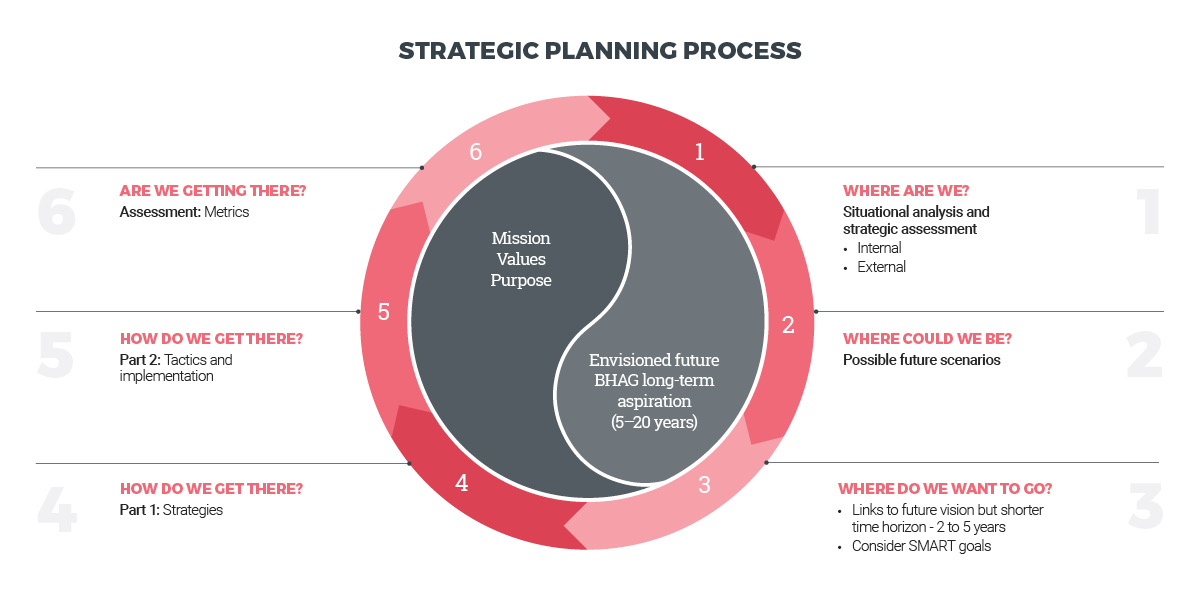WANTED: Strategic leadership for effective organizational change.
METHOD: A no-nonsense, practical guide to three things you can do to transform your impact.
The word “strategy” has been frequently overused and abused in recent times. Has anyone ever asked you for an “un-strategic” plan? Of course not. But what exactly is meant by “strategic leadership” and why would we link it to “organizational change”?
Strategic Planning Process: Making the difficult choices
Strategy is about making choices with regard to what you’ll do as an organization as well as an individual. It requires prioritization, focus and a deliberate choice to not do some things.
It often helps to let your goals guide your difficult choices. Are your goals clear? If not, undertake a systematic analysis of your current business performance, keeping in mind changing customer preferences and competitive pressures. Will the activities that follow your strategic initiatives help you achieve your goals faster and more effectively? If so, adopt them; if not, cut them.
Beyond goals, it’s also important to think about the mission of your organization. What is your DMO’s raison d’être, or reason for being? Having clarity of purpose for long-term ambitions is essential to shaping the goals that will guide your decisions. This is a fundamental place to begin your strategy development.
Because we know that developing a strategy can seem like a daunting task, we have illustrated these components into a Strategic Planning Process (below) to help guide you through it. The idea is to start the process at the centre, then move to the top and work clockwise. The wheel can help guide your strategy assessment, starting with the vision and ending with measurement.

Kotter’s 8-Step Process for Leading Change
Why is it that good strategy often fails to be implemented? Have you ever proudly reread a strong strategy document only to wonder why it didn’t have the impact you anticipated? Dr. John P. Kotter popularized one of the most effective approaches to tackling this challenge in his 1996 book, Leading Change, wherein he proposed eight steps for implementing new strategies. This process reflects the reality that a major new strategic direction requires some sort of organizational change. Failing to move forward on the earlier steps leaves a weak foundation for later, simultaneously making failure more likely. Kotter’s eight steps are:
- Establishing a Sense of Urgency
- Creating the Guiding Coalition
- Developing a Vision and Strategy
- Communicating the Change Vision
- Empowering Employees for Broad-Based Action
- Generating Short-Term Wins
- Consolidating Gains and Producing More Change
- Anchoring New Approaches in the Culture
Is it possible things have changed since 1996? Kotter reviewed his process in 2014, making modifications aimed at speeding up activities and running them in parallel as well as at scale. But the fundamental discipline and logic of this framework is a good starting point—one that remains relevant today. For example, complacency among employees can doom a new strategy to fail at step one. You can avoid similar situations by using Kotter’s eight steps to address the practicalities of what it means to be a strategic leader in your organization.
The 7-30-90 plan
Finally, relating back to the early steps in the Kotter model, consider your 90-day plan. Much has been written about how important the first 90 days are for new leaders joining an organization. But for those already in the organization, the forces of inertia stand to hold you back even more. The premise is that if you don’t make significant progress within 90 days, then the status quo and predetermined conventions of the organization will reassert themselves.
Taking this a step further, consider your 7-30-90-day program of change for strategic leadership. Knowing that you cannot start at day 90, you need to break things down into specific stages early on. What can you do in the first seven days, and then in the first 30 days, that significantly moves the dial toward implementing your new strategy? How can you make this measurable, tangible and credible? If you cannot stand up at seven days, or 30, to show progress, then consider whether you will be able to do so at 90 or 365 days. Look carefully at your role and ask yourself how your strategic leadership will differ from some of the less successful approaches you’ve witnessed with others.
Though past failures can discourage people from creating a new strategy, understanding implementation can help lead the way beyond cynicism. Better yet, strategy doesn’t need to be complicated when the planning process is clearly defined, and that’s exactly where the Strategic Planning Process can help. An effective strategic leader must recognize the different stages in the organizational change game to make the systematic and deliberate choices that will create a strong plan for the future.
Related reading: The responsive DMO: Why defining effective leadership is critical to overcoming industry disruption
Destination Think has a full range of services and unmatched international expertise to support the development and implementation of your strategic plan. Stay relevant; contact us to find out how we can help.










The main dilemma in Destination Management & Strategic Planning is: There is NO Authority “to act as big boss in regional tourism” and iti is almost impossible to reach concensus between the local stakeholders to apply some decisions of Strategy within the particular Destination. Even National Governments fail to exercise full and apropriate Authority within the real complex markets, where “the need for innovative models” are emerging recently as a solution for this worldwide vital needs to be fulfilled. See: http://bit.ly/NEWtourism
Good comment. Zafer has a point and it is a kind of frustration that is often heard. This is a multi-stakeholder model that requires a lot of energy to get everyone around the table. But these rapidly changing markets will make the demand for collaboration and destination management inevitable. Design Thinking is one of methods that are often used to come out of the impasse. Things are starting to move in Europe. Personally, I don’t think we should confuse ‘leadership’ with ‘acting as a boss’. See: https://destinationthink.com/responsive-dmo-leadership/